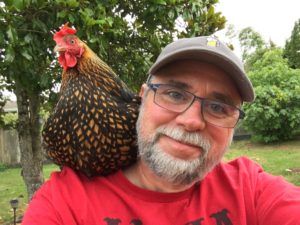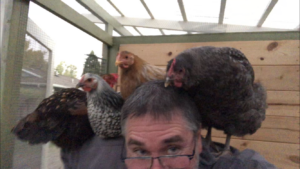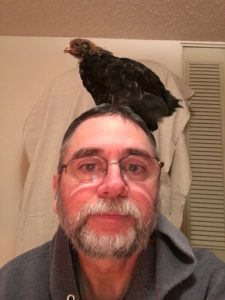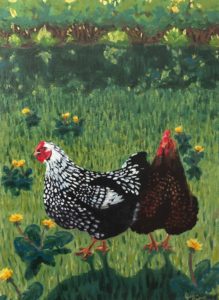
A man and his chicken
It’s my pleasure to have my friend, Bill Cameron, join us today. I’m a big fan of his writing ever since I read his debut book LOST DOG. Bill was in my debut authors group for the International Thriller Writers (ITW) in 2008. That book featured an unlikely kleptomaniac anti-hero smart ass, Peter McKrall, with his unique voice that has always stuck with me. It launched Bill’s detective series that features Detective Skin Kardash.
I also follow/harass Bill on Instagram (@bcmystery) where he posts pics of his urban chickens. His daily videos and pics of his chicken drama are tons of fun and addictive, like his writing. Thanks for being our guest, Bill. Shake a tail feather and take it away.
***
Much of my day was spent chasing chickens around my yard—an act of pure slapstick if there ever was one. Usually the ladies will come right up to me (probably because I often have treats), but today they sensed I had something else in mind. So they fled, making comical “bock-bock-bock” sounds as they went. I was no doubt equally comical, trying to both run and scoop up indignant chickens simultaneously. The result was a kind of bow-legged lurch with my hands flapping around near ground level. I may have fallen, but if you don’t have video you can’t prove anything.

My problem, or rather the chickens’ problem, was a possible infestation of scale mites. These awful little bugs burrow under the skin of a chicken’s legs, drink blood, and can wreak havoc on the well-being of a flock. (Do not image search for “chicken scale mites” unless you want to see true horror.)
Now, I say possible infestation because until the the situation gets really bad, the vermin are difficult to see. Some discoloration on the legs of our oldest hen, Hinie, was the only indication something might be amiss. That discoloration could also mean nothing at all, but since we don’t want the mites to get a leg-hold, I decided to address the problem proactively.
The treatment is basically Chicken Spa Day, which probably sounds nice to you and me. And in fact some chickens enjoy a soak in a warm bath and maybe a massage. (Do image search for “chicken taking a bath” for some entertaining pics.) Not so much our ladies. But I was not deterred.
In advance, I’d prepared a warm Epsom salts bath with a little mild soap. As I caught them, the girls each got a soak and a mild scrub to clean off any mite eggs or mites that hadn’t yet burrowed. Then, after they were dried off, I coated each hen’s legs with Bag Balm to suffocate the pestilent buggers who remained.

The good news is all went relatively as planned, though it took me more than an hour to get all four into the tub. (Farm Fact: chickens are fast.) The girls had a lot to say about it, probably in the form of chicken swearing. But the endeavor was a success—though I got wetter than the girls did.
So what does this shenanigan have to do with self-care?
Well, for me, taking care of chickens is a lot like writing. It can be rewarding, fun, challenging—and also a source of heartbreak. Right now we have four girls: the aforementioned Hinie, plus Cheeks, Tuchus, and Buns. (Do you detect a theme? Guess what!) Earlier this summer, one of our first hens, Fanny, died unexpectedly. And last year, two others (Moon and Patootie) turned out to be roosters, which are verboten within city limits. That’s the heartbreak side of things. But the rest of the time there’s the slapstick comedy and the reward of eggs and affection from smart, engaged birds who each have their own personality.
When I’m away from the keyboard, I find chicken care is a good way for me to get my “I’m not an incompetent buffoon” fix—something that can be rare in my writing life. On days when things seem especially dire (“wait, did you say there’s no market for that manuscript I spent five years on?”), time with the chickens can give me a sense of worth. They need me—for food and water and spa days, and for a lap or shoulder to cluck on. And I’m up to the task.

The day Hinie pooped on Bill’s head
But as with writing, there’s no guarantee of success. They might get scale mites, and while I’m confident I have that problem in hand, the next problem might cost me a beloved pet. In the morning, I might get a manuscript rejection, but in the afternoon I might get a fresh egg and a nuzzle from a bird named after a butt.
Chicken Tending (think about it) isn’t the only thing I do for self-care. But the ways it’s like writing helps me deal with the tribulations of my writing life. Sometimes we just need a little success. For me, chasing birds around the yard goes a long way toward keeping me grounded and believing I can make a difference—on the page as much as in the coop.

Fanny (RIP) & Hinie by Bill’s daughter, Jessica
FOR DISCUSSION:
What do you do to take care of yourself?

Bill Cameron is the critically-acclaimed author of gritty, adult mysteries featuring Skin Kadash. His short stories have appeared in Alfred Hitchcock’s Mystery Magazine, Killer Year, Portland Noir, First Thrills, Deadly Treats, and West Coast Crime Wave. In 2012, his novel County Line received the Spotted Owl for Best Northwest Mystery. His latest book, the young adult mystery Property of the State, was named one of Kirkus Reviews Best Books of 2016: Teen.
Bill is currently at work on a mystery set in the Oregon High Desert.

Yesterday it was cleaning the oven–once every twelve years, whether it needs it or not. http://www.ericbeversluis.com/eric-and-the-fiery-furnace-oven-cleaning-adventures/
Bill’s chickens are sensitive about ovens, Eric. Just sayin’…
We did talk about kitchens and food a lot yesterday, didn’t we. Which raises the question whether it’s time for a column on Chicken Run. Or at least re-viewing. Bill’s hens would love it.
I wouldn’t want to give them any ideas…
I’m in scramble-mode, so other than feeding my crows (and chippies, squirrels, and turkeys), I’m tied to the desk till I meet my deadline. But I do enjoy my time with wildlife. Loved your chicken story, Bill. Welcome to TKZ!
Thank you!
Bill’s chickens are beautiful. RIP Fanny, you pinup girl you.
To take care of myself, I guard my sleep time because I’m cranky and stupid when I’m sleep deprived!
It’s addictive to swing by Instagram to see Bill and his “girls.” Bill and his wife Jil spend time with the chickens & other critters that they post on Instagram, videos too. There’s a whole community online for #urbanchickens. Who doesn’t need a chicken chuckle at the end of a writing day?
I can appreciate that. My own sleep has never been great, but even so an extra rocky night can throw the next day into a funk.
Our girls really are beauties. I think they know it too. ?
Nothing like pampered poultry.
Echoing Sue and Priscilla – your birds are indeed beautiful and I loved your story about them. Thanks for introducing them to us and welcome to TKZ.
Thank you!
I actually have a serious question for you, Bill.
Where do you get your chickens? After poor Fanny died, after a respectable amount of time, you brought home new friends for Hinie and they’re beautiful. I wondered if you got them from a special place.
I live in Texas, but I wouldn’t know where to get chickens not wrapped in cellophane. (Sorry, girls.)
There are a lot of possibilities. We got our first flock, which included Hinie and Fanny, at a local urban farm store. That particular store has chicks available most of the year, though spring is the most common time for people to get chicks because they will be mature and laying by summer or early fall.
Feed stores and larger farm stores will typically have chicks in the spring. Those places will tend to focus on the “working” breeds, including meat birds (plus turkey poults, ducklings, guinea fowl—you name it). But anywhere that sells chicks will have heritage breeds too.
What this means is that you can probably find chicks in stores near you no matter where you live in the U.S. And, if fact, I know that some of the chicks sold at the Eugene Backyard Farmer were bred in Texas. The breeders ship the newly hatched chicks overnight via UPS or FedEx! And you can order chicks directly from breeders and have them shipped right to your house.
After Fanny died, we actually got our new ladies very quickly. Chickens need a flock, and Hinie was clearly in distress by herself. We’d always meant to have four birds, but when two of our originals turned out to be roosters, we dawdled replacing them. That made the loss of one of our two especially tough.
Fortunately, we had a friend who raises chicks up to pullet (teen chicken) age before selling them. So we were able to get our pick from a maturing flock of three-month old rowdies. We also learned about the concept of Chicken Math, wherein if you lose one hen you somehow end up with three to replace her. (It’s a mystery!) One advantage of buying older birds is we were sure they weren’t secret roosters. Plus, we could integrate with Hinie more easily.
Our girls are Wyandotte hens (Hinie, Cheeks, and Buns) plus a Cuckoo Maran (Tuchus). The main difference between heritage and working breeds is appearance, though of course some breeds have been bred for egg production or rapid growth.
We specifically chose our breeds for beauty, personality, suitability for backyard life, and finally eggs. Our girls will average 200 per year, which is actually quite a bit, if not enough for commercial egg producers. When we had only Hinie and Fanny, we got just about the right number of eggs for the two of us. The girls did slow down last winter, which included a six-week break from late December to early February. This year, once our youngsters start laying, we’ll have a surplus—which will probably go to friends and neighbors.
The Wyandotte girls lay light brown eggs, but Tuchus the Maran will lay a dark brown egg—chocolate colored. That’s just the shell though. The yolk and white will be the same as any egg.
The big difference between backyard eggs and commercial eggs is in the yolks and whites. We see deeper yellow, larger yolks and less runny whites. The yolks are also firmer, even to the point that they can hold a nearly spherical shape after cracking them into a bowl. The taste isn’t hugely different (in blind taste tests people have a hard time telling the difference between commercial eggs and backyard eggs), but in terms of nutritional value our eggs are much better.
And there is more about chickens than you probably expected. And I just scratched the surface!
Really good stuff, Bill. I was wondering about the color of egg shells and the yokes. Didn’t realize that I could control some of the things I like the least, like runny whites. Makes me want to buy differently at the store.
You really ARE a chicken scientist.
Heck, I’ve still got tons to learn. But it’s fun, so I don’t mind at all!
How did you and your wife get into chickens? Who’s idea was it?
With a busy schedule of writing and travel, chickens would not be my first thought for a hobby.
I’m not sure whose idea it was originally. Before we moved to Eugene five years ago, we had neighbors who kept chickens and ducks, and I used to love listening to them as I worked. Jill was into the idea too, but it wasn’t until we moved to Eugene and decided we were going to stick around for a while that we finally took the plunge.
Most of the time chickens are very easy to care for. Our girls are more pets than egg producers, so we spend a lot of time hanging out with them the same way we do our cats. But in terms of actual work, it’s basically food and water, gathering eggs, and tidying the coop/run as needed. Cleaning the litter boxes for the cats probably takes more time than that.
Of course the scale mites spa day was a bit more involved, but that situation is the exception rather than the rule.
Of course, the “Pet Who Poops Breakfast” isn’t for everyone. They’re definitely a lifestyle choice that has to work for you.
The way you enjoy your girls, it makes me want to try raising them, but it would break my heart to have one die. My property backs up to a greenbelt and bike trail system and there are coyotes back there. I’d be afraid that would be like ringing a dinner bell. I’ll have to settle on enjoying YOURS.
As for your writing, Bill, you seem to have a theme of anti-heroes and you write unusual characters who are underdogs.
Can you share your process on how you build a character and what attracted you to the ones you’ve written?
Oy, now this is a big question with an even bigger answer. But what it really boils down to the fact that I’m most interested in characters who are just a mess. And this interest expresses itself by the strange desire to spend a lot of time inside the heads of these people.
I sometimes think of myself as a Method Writer. A lot of the early development for a story consists of me writing as the character. Journal entries, letters to other characters, personal explorations. I also sometimes interview the character from different perspectives, or describe them from the point of view of their antagonists.
The result is a lot of words that no one but me will ever see. My last WIP landed at 97,000 words. Out of curiosity, I checked the total word count of all the ancillary files, and it came out to nearly 400,000. Of that, only about 20K was plotting and outlining. The rest was character exploration.
Excessive? Maybe. But so far it works for me. (And just yesterday I heard from a writer whose roughly 100K novel had about 600K in word count, so I’m hardly a record holder!)
Wow. But I can see how your method can reinforce the character you have in your mind. Most people are visual learners. Whether you do your character exploration online or handwritten, your eyes still see the traits & backstory. Those notes create a visual representation in your mind as if that character were real. I can totally see what you mean. Thanks for the explanation. Your hard work really shows in your writing.
Jordan, thank you for inviting me to be your guest today. It was lots of fun to talk about the ladies and even writing a little!
Thanks for being our guest at TKZ, Bill. Keep putting out stellar books & take care of the girls. I’ll see you on Instagram.